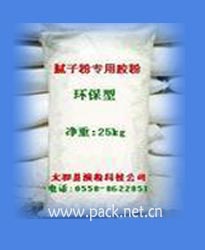 Abstract : The preparation method of corn starch adhesive modified by acrylic acid (AA)-acrylamide (AAm) copolymer was introduced. The effects of various factors such as polymerization temperature, AA-AAm copolymer, initiator and starch content, and pH on adhesive properties were studied. The modified adhesive exhibits good adhesive properties and is suitable for the production of corrugated boxes.
Abstract : The preparation method of corn starch adhesive modified by acrylic acid (AA)-acrylamide (AAm) copolymer was introduced. The effects of various factors such as polymerization temperature, AA-AAm copolymer, initiator and starch content, and pH on adhesive properties were studied. The modified adhesive exhibits good adhesive properties and is suitable for the production of corrugated boxes.
Keywords: AA-AAm copolymer corn starch adhesive viscosity adhesive strength
Corn starch adhesive has the advantages of high adhesive strength, non-corrosiveness, simple preparation, low cost, good moisture resistance, etc. It is widely used in the manufacture of corrugated cartons. With China's opening up to the outside world, the export trade has increased, the volume of corrugated cartons has been increasing, and the quality requirements have become higher and higher. Adhesives produced by the method of oxidizing and gelatinizing corn starch have not been adapted to the demand for high-quality corrugated cartons. In order to seek high-quality adhesives for corrugated paperboard, people use polyvinyl alcohol [, polyacrylamide [, urea-formaldehyde resin, polyvinyl formal, etc. to modify the corn starch adhesive. The authors prepared a fast-drying corn starch adhesive by copolymerizing AA-AAm in PVA solution first, and then adding corn starch to heat paste, which is suitable for the rapid production of corrugated boxes.
1 Experimental section
1.2 The main raw materials
Acrylic acid (AA), acrylamide (AAm), industrial polymerization grade; polyvinyl alcohol (PVA1799), corn starch, ammonia, industrial products; ammonium persulfate, sodium bisulfite, chemically pure.
1.2 Preparation method
A certain amount of PVA and water were added to the reactor, and the PVA was completely dissolved by stirring at 90° C. for 4 hours. The temperature was lowered to 80° C., a mixture of AA and AAm, and a mixture of ammonium persulfate and sodium bisulfite were added dropwise, and the reaction was completed after about 11.5 hours, and the reaction was incubated for 0.5 hours. Then add cornstarch, continue to heat and stir and gelatinize, add a preservative, stir evenly, lower the temperature to below 50°C, and adjust the pH to 810 after discharging with ammonia.
1.3 Performance Test
Viscosity Determined according to GB/T 2794-1995.
The PH value was measured with a PHS-3 acidity meter.
Adhesion strength According to GB 5034-85
2 Results and Discussion
2.1 Several Factors Affecting Viscosity
2.1.1 Effect of polymerization temperature on viscosity
The effect of AA-AAm copolymerization temperature on viscosity is shown in Figure 1.

As can be seen from Figure 1, the viscosity increases with the increase of the reaction temperature, and decreases after reaching the maximum value. Because the reaction temperature follows the reaction rate constant  Relational. When the temperature rises, the AA-AAm reaction rate constant increases, the molecular mass of the copolymer increases, and the viscosity increases. The reaction temperature continues to increase, the depolymerization reaction also accelerates, and the molecular weight of the copolymer decreases, so the viscosity decreases. The reaction temperature is controlled at about 80°C.
Relational. When the temperature rises, the AA-AAm reaction rate constant increases, the molecular mass of the copolymer increases, and the viscosity increases. The reaction temperature continues to increase, the depolymerization reaction also accelerates, and the molecular weight of the copolymer decreases, so the viscosity decreases. The reaction temperature is controlled at about 80°C.
2.1.2 Effect of initiator dosage on viscosity
During the polymerization process, the amount of initiator was increased, the polymerization rate was increased, and the viscosity of the system was increased, as shown in FIG. 2 . However, when the amount of initiator is too large, the free radical concentration in the system increases, the chain termination speed increases, the chain growth rate decreases, and the molecular mass of the copolymer decreases. The initiator mass fraction was 0.6% and 0.8% was better.

(to be continued)
Children Velcro Suits,Sealant Coverall,Non-Disposable
Rain Poncho,Beach Umbrella Co., Ltd. , http://www.nsraincoat.com